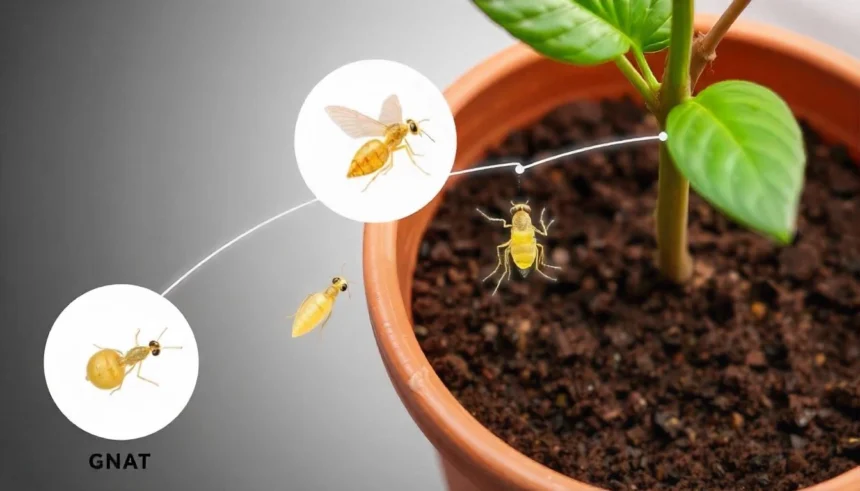Introduction
Gnats are small, flying insects that are commonly found in homes, particularly in kitchens, bathrooms, and near houseplants. While they are generally harmless, their presence can be frustrating and unsanitary. Understanding the science behind gnat infestations is crucial for effective eradication. This article explores their breeding habits, environmental preferences, and the role of moisture in their reproduction. Additionally, we will discuss proven natural and chemical solutions for gnat control and prevention.
The Biology and Breeding Habits of Gnats
Gnats belong to various families within the order Diptera, including fungus gnats (Sciaridae), fruit flies (Drosophilidae), and drain flies (Psychodidae). Each species has distinct biological characteristics but shares commonalities in breeding habits and environmental preferences.
Life Cycle
Gnats undergo a four-stage metamorphosis: egg, larva, pupa, and adult. Their entire life cycle typically lasts between 2 to 4 weeks, depending on environmental conditions.
- Egg Stage: Female gnats lay hundreds of eggs in moist organic material, such as soil, decaying fruit, or drain sludge.
- Larval Stage: The larvae, which are legless and worm-like, feed on fungi, decomposing matter, and plant roots.
- Pupal Stage: Larvae develop into pupae before emerging as adults.
- Adult Stage: Adults have a short lifespan (about a week), during which they reproduce rapidly.
Environmental Preferences and the Role of Moisture
Moisture plays a crucial role in gnat infestations, as it creates an ideal breeding environment for many species. Gnats thrive in areas with high humidity and organic material, including:
- Overwatered houseplants, where fungus gnats feed on mold and organic debris.
- Fruit bowls or trash bins containing decaying produce, which attract fruit flies.
- Clogged drains and damp areas, where drain flies breed in organic buildup.
- Damp basements, leaky pipes, and bathrooms, where general humidity encourages infestations.
Reducing moisture levels and eliminating organic debris are essential steps in controlling gnats.
Effective Methods to Eliminate Gnats
Combating gnats involves a combination of natural and chemical solutions. Below are proven methods categorized for ease of implementation.
Natural Remedies
- Apple Cider Vinegar Traps
- Fill a shallow bowl with apple cider vinegar and a few drops of dish soap. The vinegar attracts gnats, while the soap breaks the surface tension, causing them to drown.
- Sticky Traps
- Yellow sticky traps can be placed near houseplants and infested areas to capture adult gnats.
- Hydrogen Peroxide Soil Treatment
- Mix one part hydrogen peroxide with four parts water and apply it to houseplant soil to kill larvae without harming plants.
- Essential Oils
- Citronella, lavender, and peppermint oils can act as natural repellents when sprayed in affected areas.
- Reducing Moisture and Organic Material
- Avoid overwatering plants and ensure proper drainage.
- Dispose of rotting fruits and vegetables promptly.
- Clean drains regularly to remove organic buildup.
Chemical Solutions
- Insecticides and Sprays
- Commercial insect sprays containing pyrethrin are effective in killing adult gnats.
- Biological Control (Beneficial Nematodes)
- Beneficial nematodes (Steinernema feltiae) can be introduced to soil to eliminate larvae.
- Drain Cleaners
- Enzymatic drain cleaners help remove organic matter where drain flies breed.
- Soil Treatment with Diatomaceous Earth
- A natural pesticide, diatomaceous earth dehydrates and kills gnat larvae in plant soil.
Prevention Strategies
Once gnats are eliminated, preventative measures ensure they do not return:
- Store fruits and vegetables in the refrigerator or airtight containers.
- Keep kitchen counters, sinks, and trash bins clean and dry.
- Ensure proper ventilation in damp areas such as basements and bathrooms.
- Regularly inspect houseplants for signs of gnats and adjust watering habits accordingly.
Conclusion
Gnats are persistent pests that thrive in moist, organic-rich environments. Understanding their biology and environmental preferences allows for targeted control measures. A combination of natural and chemical solutions effectively eliminates infestations, while preventive strategies ensure long-term success. By maintaining a dry, clean environment, homeowners can significantly reduce the likelihood of future gnat problems.







